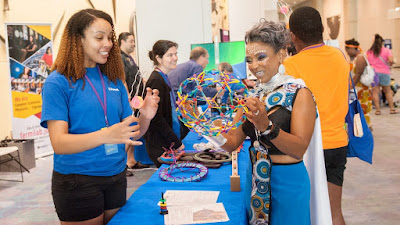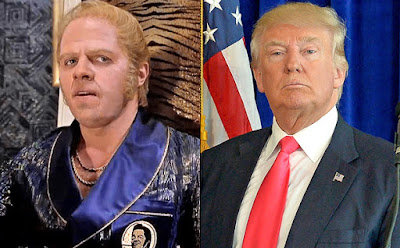Topics: Civics, Civil Rights, Existentialism, Fascism, Human Rights
We got here from a so-called "reality show" about a faux billionaire:
The Apprentice was first aired in 2004, and presented Trump as the ultra-successful real estate deal-maker who would choose from a cast of candidates competing for a job in the Trump Organization. Trump's catch phrase on the show was, "You're fired," which he would deliver pointing at that week's unsuccessful candidate.
Editor Jonathan Braun told the publication that Trump would fire contestants on the show on a whim, forcing editors to "reverse engineer" programs to make Trump's decisions seem coherent.
Show producer Mark Burnett remarked, "We know each week who has been fired, and therefore, you're editing in reverse." Amid a series of firings and resignations in the Trump administration, he remarked, "I find it strangely validating to hear that they're doing the same thing in the White House."
Production staff described how their job was to elevate Trump's image, whose star had fallen since his 1980s heyday of fame.
"Most of us knew he was a fake," Braun, who worked on six series of the show, told The New Yorker. "He had just gone through I don't know how many bankruptcies. But we made him out to be the most important person in the world. It was like making the court jester the king."
Working With Trump 'Was Like Making The Court Jester The King' Says 'Apprentice' Producer
Tom Porter, Newsweek
Louis Anslow points out a certain German chancellor was initially considered a joke as well. As he posits, "how did that work out?"
For someone that constantly carps "no collusion" and "the Russian hoax," he gives fodder to those who think otherwise:
Biarritz, France (CNN) - A sharp and sometimes bitter disagreement broke out between President Donald Trump and several G7 leaders over whether to allow Russia back into their club during a welcome dinner on Saturday, according to two diplomatic officials and a senior US official with knowledge of the exchange.
Trump, as he did in public over the course of the summit, ardently advocated for it, the officials said. As the leaders discussed issues like Iran and fires in the Amazon rain forest, Trump interjected and asked why Russia should not be included in the talks, given its size and role in global affairs.
That met sharp resistance from some of the leaders, principally German Chancellor Angela Merkel and British Prime Minister Boris Johnson. They argued Russia had grown more anti-democratic since it was ejected in 2014 for its incursion into Ukraine, disqualifying it from rejoining the G7.
The dispute amounted to one of the most heated moments of this weekend's G7. Afterward, Trump publicly insisted the gathering was marked by displays of unity and cooperation. While the leaders did hold amiable discussions throughout both the dinner and other sessions, the exchange on Russia was notable for the fiercely argued views on both sides, the officials said.
He might as well put on a Russian ballerina tutu, "I love Putin" t-shirt and cheerleader pompoms:
It wasn’t the first time Trump has said his predecessor was somehow responsible for the act of aggression that got Russia booted from the G-8, and he’s never been able to come up with anything better than “whatever” in explaining how exactly President Obama was supposed to stop the annexation. All that matters, according to Trump, is that Obama is bad and Putin, even at his most anti-democratic, is incapable of wrongdoing. Just like Trump.
Trump’s anti-Obama screed on Monday came after he was asked about his belief that Putin should be readmitted to the G7 despite showing no remorse for his indiscretions, a cause Trump championed at last year’s G7 in Canada, and again over the weekend in France. As the Washington Post reported on Monday, Trump’s desire to bring Putin back into the fold was far more intense in Biarritz than the president let on publicly, which is saying a lot.
His campaign began on Saturday night, when world leaders met for the first time over dinner. As the Post writes, after beginning cordially, the occasion went “off the rails” when Trump started lobbying on behalf of Putin. His dining partners were not pleased:
“The entire 44-year vision of the G-7 gathering, according to the non-U.S. participants, is to hash out global issues among like-minded democracies. So the discussion quickly turned even more fundamental: whether the leaders should assign any special weight to being a democracy, officials said.
Most of the other participants forcefully believed the answer was yes. Trump believed the answer was no. The push back against him was delivered so passionately that the U.S. president’s body language changed as one leader after another dismissed his demand, according to a senior official who watched the exchange. He crossed his arms. His stance became more combative.”
Not even Boris Johnson, the new Brexit-happy prime minister of England, was on Trump’s side. The next day, he reportedly gave plaudits to French President Emmanuel Macron for how he diffused the argument over dinner the previous night. “You did very well there last night,” Johnson said, according to the Post. “My God, that was a difficult one.
Trump Used the G7 to Remind the World He’s on Team Putin, Ryan Bort, Rolling Stone
We are five years and forty-eight hours from halcyon days when tan suits were the controversial rage. We're in a daily abusive relationship with a gas lighter and his cult following (a short list): Alex Jones between throwing obvious psychotic fits and accusing anything beyond his third grade comprehension of reading and math to "false flag operations"; feckless evangelicals that have given up any pretense of moral authority, KKK et al racist domestic terrorists and Q-Anon, the natural online evolution from the outer fringes of 4CHAN and 8CHAN per "It Came From Something Awful" author Dan Beran. It could yet become more awful. Margaret Atwood's "The Handmaid's Tale" was a fanciful, dystopian novel and a fascinating Hulu series: not a blueprint. White evangelicals have strange hard on's.
Orange Satan's spiritual and hair mousse twin in the old country suspended parliament to popular backlash, an assault on the British Constitution that can only push our own constitutional assaults to the forefront of his "limited cognitive ability, and of generally dubious character" per General "mad dog" Mattis. 84 environmental regulations are being rolled back, inclusive of methane - a gas along with carbon dioxide that exacerbates global warming, as fires burn in the Amazon and a hurricane barrels towards Florida. The Tongass National Forest mitigates climate change like the Amazon - he's ordered chopped down. We are becoming Apokolips.
It makes as much sense as rolling coal exhaust trucks "owning the libs" polluting the same air they breathe on the same planet. It's the equivalent of shooting their own feet...and laughing about the gaping hole.
Nothing about what he does makes any sense other than political penis envy of the smarter, (bigger hands), more popular black president who's legacy he's hellbent in cartoon megalomania villainy in trying to destroy. Champagne glasses are clicking in the Kremlin, who like their smokestack gremlin brethren ALSO live on the same planet!
In comic books, good typically triumphs over evil.
This life is not a comic book.
There will be no movie...nor a sequel.







 A friend bought a copy of The Chronocar with the simple intention of supporting me. He decided to read it to see what it was all about. He was surprised that he enjoyed it so much because, as he told me later, “I hate science fiction!” At least two other people have written reviews where they clearly express a dislike or ambivalence for science fiction, yet they admit that they enjoyed my story.
A friend bought a copy of The Chronocar with the simple intention of supporting me. He decided to read it to see what it was all about. He was surprised that he enjoyed it so much because, as he told me later, “I hate science fiction!” At least two other people have written reviews where they clearly express a dislike or ambivalence for science fiction, yet they admit that they enjoyed my story.






